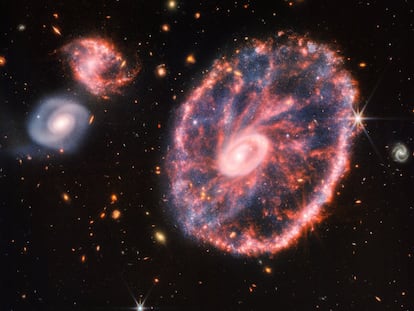‘Perfect solar system’ discovered with six planets that ‘dance’ in sync
Researchers consider this a key finding to better understand and explain planetary formation processes

Although technically there is only one planetary group called the “solar system,” astronomers have already found more than 4,100 stars with planets orbiting around them. An international collaboration involving a significant Spanish contingent has discovered another planetary system to add to the list, but this one is unique among its kind. The star HD110067 is orbited by six exoplanets that revolve around it in a synchronized dance, in a phenomenon known as orbital resonance. It is not common for systems to retain this characteristic, indicating that the system has not undergone any major changes throughout its billion-year history. Researchers consider it key to better understanding and explaining planetary formation processes. The discovery was published recently in the journal Nature.
HD110067 is a star that is 20% smaller and cooler than the Sun and is located in the northern constellation of Coma Berenices, about 100 light years away from Earth. The first suspicions that this star hosted a planetary system came in 2020. NASA’s planet hunter satellite, TESS, recorded a decrease in brightness (similar to an eclipse), which indicated the existence of at least two planets passing in front of the star. Two years later, TESS observed the same star again, but presented data inconsistent with the first interpretation. This contradiction piqued the interest of Rafael Luque, a Spanish astrophysicist, and his colleagues at the astrophysics department at the University of Chicago. “That’s when we decided to use CHEOPS. We were looking for signs among all the potential periods that those planets could have,” says Luque.
With the help of the European Space Agency’s (ESA) CHEOPS space telescope, the team identified a third exoplanet. They realized they had found the key to unlocking the entire system because it was now clear that those three planets were in orbital resonance. “CHEOPS provided us with a configuration that allowed us to predict all the others,” says the astrophysicist. Like “detectives,” they combined the data from both telescopes, and with mathematical models of gravitational interactions, they predicted the existence of three outer planets.
Later observations confirmed that they were precisely where this rhythm (the resonance chain) predicted they would be. The outermost planet takes 20,519 days to orbit HD110067, almost 1.5 times the orbital period of the next planet, which takes 13,673 days. This in turn is almost exactly 1.5 times the orbital period of the inner planet, at 9,114 days. That is, when the planet closest to the star makes three complete revolutions around it, the second makes exactly two during the same time. This is called 3:2 resonance. The six planets form a resonance chain in pairs of 3:2, 3:2, 3:2, 4:3 and 4:3, the ESA explains. This results in the closest planet completing six orbits in the time it takes the outermost planet to perform one. The authors have not ruled out the existence of more coordinated “dancing” planets in this system.
The exoplanets hosted by HD110067 belong to the group of so-called sub-Neptunes: planets that are smaller than Neptune (four times the diameter of the Earth). When it comes to imagining what they are like, Ignasi Ribas, an astrophysicist at the Spanish National Research Council (CSIC), who also participated in the study and has compiled years of work searching for exoplanets, clarifies that they are not similar to Earth: “They are very hot planets that can reach a temperature of 200 degrees.” The habitable zone of the system has not yet been deciphered either, in other words, how many planets are in the temperate zone that would allow life. Future observations could also determine whether the planets have rocky or water-rich interior structures.
HD110067 is also the brightest known system with four or more planets. Some worlds probably have atmospheres with a high presence of hydrogen and are good candidates for carrying out new analyzes to determine the chemical composition and other properties of their atmospheres. What will be necessary to study this special planetary system? An approach with adequate equipment for observation and a good candidate for this is the James Webb Space Telescope. It is the most powerful telescope at scientists’ disposal and has only been in operation for a year. Rafael Luque, the study’s main author, reveals that his team aims to work with the telescope in the future.
A key discovery for the future
Planetary systems tend to form in resonance, but this is a rhythm that can be easily disturbed. “Clashes between planets, fusions, and ruptures, the birth of giant planets like Jupiter, or the close passage of another star can alter the orbital balance,” explains Ribas. Among the thousands of multiplanetary systems, 99% are not in resonance, but could have been at one time. The HD110067 system is part of that scarce 1%, with a special value for science, as it can provide information to astronomers about the formation and subsequent evolution of the planetary system. Both Ribas and Luque compare the discovery to finding a fossil. “It shows us the configuration of a planetary system that has survived intact since its formation,” says Luque.
Astrophysicist Eva Villaver applauds the new study, in which she did not participate. “Each system that we discover that has unique characteristics contributes data to our understanding of formation processes. Science studies these exoplanets in case they can give us clues about what makes our solar system unique and why, although sub-Neptune planets are so frequent, we do not have them,” the researcher and director of the Space and Society Office of the Spanish Space Agency, explains. Thus, by studying exoplanets and distant solar systems, astronomers hope to solve the great mysteries that still surround the solar system and provide more information to the never-ending question of whether there is life elsewhere in our galaxy.
Sign up for our weekly newsletter to get more English-language news coverage from EL PAÍS USA Edition
Tu suscripción se está usando en otro dispositivo
¿Quieres añadir otro usuario a tu suscripción?
Si continúas leyendo en este dispositivo, no se podrá leer en el otro.
FlechaTu suscripción se está usando en otro dispositivo y solo puedes acceder a EL PAÍS desde un dispositivo a la vez.
Si quieres compartir tu cuenta, cambia tu suscripción a la modalidad Premium, así podrás añadir otro usuario. Cada uno accederá con su propia cuenta de email, lo que os permitirá personalizar vuestra experiencia en EL PAÍS.
¿Tienes una suscripción de empresa? Accede aquí para contratar más cuentas.
En el caso de no saber quién está usando tu cuenta, te recomendamos cambiar tu contraseña aquí.
Si decides continuar compartiendo tu cuenta, este mensaje se mostrará en tu dispositivo y en el de la otra persona que está usando tu cuenta de forma indefinida, afectando a tu experiencia de lectura. Puedes consultar aquí los términos y condiciones de la suscripción digital.
More information
Últimas noticias
Most viewed
- Charles Dubouloz, mountaineering star, retires at 36 with a farewell tour inspired by Walter Bonatti
- CBS in crisis after pulling a report on Trump’s deportations to El Salvador (which later leaked online)
- The Florida Keys tourist paradise is besieged by immigration agents: ‘We’ve never seen anything like this’
- December Social Security and SSI payments: Dates, double checks and the 2026 COLA increase
- Bukele clan fumes over investigation exposing their new wealth










































